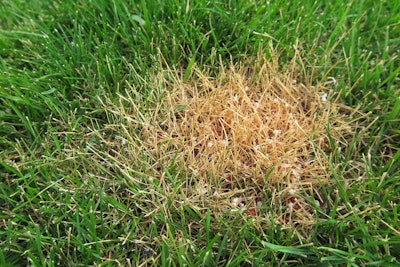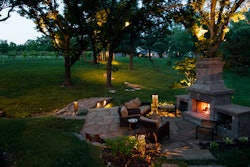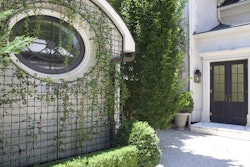
When lawns get more fertilizer than they can process, burn occurs, and it can happen due to many conditions, such as applying an excess of fertilizer, overall turf health, or weather conditions. When these fertilizers accumulate, their salts will draw the water away from the root systems, which results in the lawns turning yellow or brown and eventually dying.
Before you decide on which fertilizer would best suit your customer’s landscape, check out some of the differences between nitrogen sources and how knowing these differences could help you avoid burning the turf.
Get to know the product
Getting to know your fertilizers and what goes into them is crucial before doing any kind of application.
The three major ingredients needed by lawns are nitrogen, phosphorus and potassium (NPK). Nitrogen is required the most, but keep in mind that too much nitrogen can cause an excessive amount of top growth, which can cause problems.
It’s also good to remember that the type of nitrogen used in the fertilizers will play into how they can be used. Some companies manufacture nitrogen fertilizers and input suppliers will mine the materials to make phosphorus or potassium fertilizers.
Other companies can take these products and add stabilizers or coatings that will create stabilized, slow-release and controlled-release formulas, which then creates enhanced-efficiency fertilizers (EEFs).
The fertilizers will then be blended and made into the final product, and the percentage of EEFs in the fertilizers will affect how long the blend will be able to feed the turf. Blends that contain 50 percent or more EEF are better at enhancing the longevity of the fertilizer.
Slow-release fertilizers
To help reduce the burn potential, it’s recommended that you use fertilizers that are the slow-release variety.
“Look for turf fertilizers that have at least a portion, 25 percent or more, of their nitrogen in the form of slow-release N,” the Michigan State University (MSU) Extension says online. “Your (customer’s) lawn will benefit from lower risk of fertilizer burn, and the growth will be more even. The environment will benefit from lower risk of fertilizer moving into ground and surface water, and you will benefit from having a beautiful lawn that needs to be mowed and fertilized less often.”
Since the nitrogen sources in this type are controlled release, it will take longer to see a noticeable change in the growth and greening, but taking time to discuss these slow changes with the customer beforehand will help set his/her mind at ease when it comes to expectations.
It’s also worth mentioning that not all slow-release fertilizers will contain only controlled-release nitrogen. Many products will contain a mixture of both fast and slow-release nitrogen sources, which can ultimately provide a good balance of fast coloring, reduction of burn and increased product longevity.
Typically, slow-release fertilizers will be a bit more costly, but it could end up saving your customer money per application due to the controlled aspect of the product.
Even though the likelihood of turf burn is lower when using slow-release fertilizers, it’s still a good idea to irrigate the turf thoroughly after applying.
Quick-release fertilizers
Quick-release fertilizers, as the name would indicate, provide a fast availability of nitrogen to the lawn after it’s been applied.
The benefits associated with this type of fertilizer are quicker greening and rapid growth, although this can vary depending on your customer’s lawn and location. Because these fertilizers are based on water-soluble nitrogen (WSN), the nutrients will be available to the turf once dissolved in water, which can typically happen when an irrigation system is involved.
The nitrogen in quick-release fertilizers will have a higher salt index, which means they can burn heat-stressed lawns because they will draw moisture out of the grass. This along with the everyday heat sapping the moisture from the area could prove detrimental to the turf.
To try and keep your customer’s lawn from feeling the burn, immediately irrigate the area after applying the quick-release fertilizers to help move the nitrogen into the soil and off the top of the grass.











